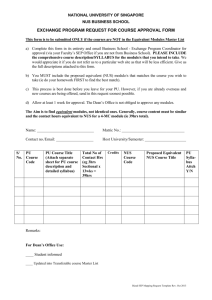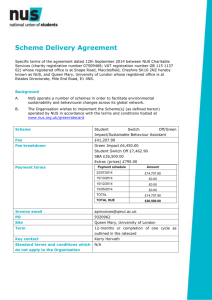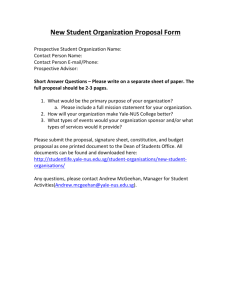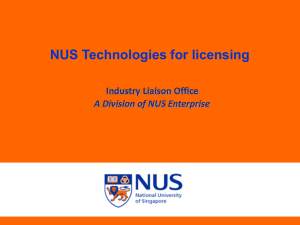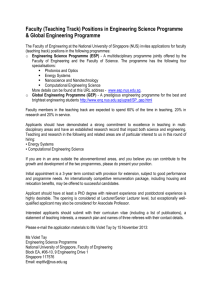Finding Carrots
advertisement
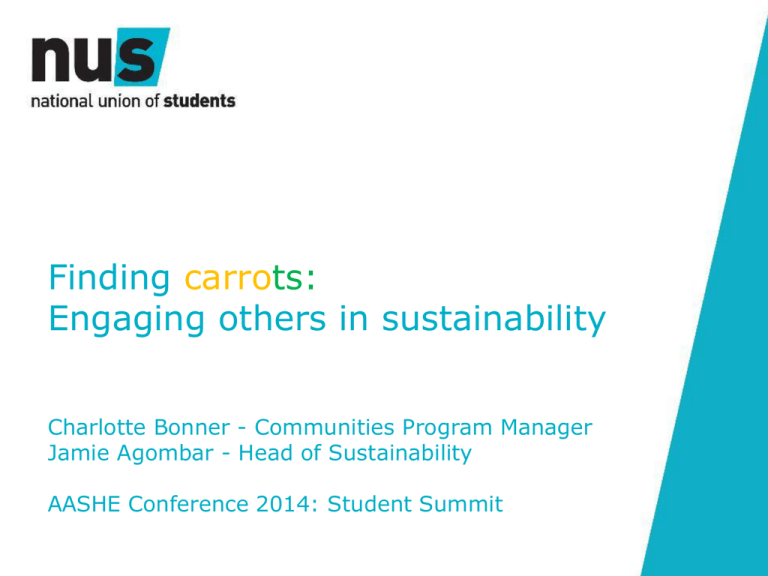
Finding carrots: Engaging others in sustainability Charlotte Bonner - Communities Program Manager Jamie Agombar - Head of Sustainability AASHE Conference 2014: Student Summit What are we going to cover? Research Funding Communications Programmes Ground rules Introductions Find someone you don’t know Introduce yourselves: who you are and where you come from Key question: what first got you interested in sustainability? Who are we? - NUS 600 FE and HE SUs • 600 students’ unions • 7 million students (2.3m in HE) • 4,700 SU staff; 500 sabbatical officers • 230 NUS staff Societies, course reps, trustees 7m students What is NUS? • NUS was founded in 1922. In 1973 NUS was the first national body to pass policy in favour of LGBT rights, elected its first women president in 1977 and its first black president in 1978. • NUS works to promote, defend and extend the rights of students and helps develop and champion strong students’ unions. • 3 core values of; Equality, Democracy and Collectivism guide NUS’ work What we do today Campaign, lobbying and research on issues that affect students • Access to and quality of education, welfare, liberation Develop and champion strong students’ unions • HR, finance, strategic support, activities coordination, digital platforms, sustainability programmes 9,010 actions completed this year, 5,566 (61%) as a result of GI Green Impact Excellence • Credit union • Community environmental audits • Greening the curriculum • Community action • Biodiversity and schools • Computer recycling • Chilli Jam Green Impact Universities and Colleges • 62 Universities and Colleges • 1,205 teams reaching 53,950 members of staff • 48,834 actions completed this year, 32,000 (65%) a result of Green Impact • MacEwan University in Canada • Video Green Impact in the Community 115 off-campus organizations 12,467 actions completed this year, 6,974 (56%) as a result of GI Total GI action actions Student involvement in GI 809 students Project Assistants and auditors Student Switch Off • • • • • • Targets students in dorms Behaviour discontinuity theory Energy-saving competition Eco Power Rangers: films, quizzes Encourages simple changes Video Student Switch Off 2013-14 • • • • • • 54 universities 150,000 students in rooms 28k students (17%) engaged 5.9% reduction; 1,159 tCO2 Schools pilot prepared SAVES = Lithuania, Greece, Sweden, Cyprus The opportunity Students’ Green Fund £5m pilot fund from HEFCE for student-led sustainability projects to be run by students’ unions in partnership with their parent institutions Four key themes: • Student engagement • Partnership • Impact • Legacy WHOLE EARTH? www.nus.org.uk/wholeearth Reclaiming the Curriculum UMSU Post-Crash Economics Society Understanding your audience • Who is your audience? • What motivates them? • What barriers are there to change? Different attitudes to sustainability Different motivations and interest Engaging others 1. Match the groups of people with the types of motivation that may appeal to them 2. Add your own ideas 3. How could you encourage them to engage with sustainability? What could you say or do to gain their support? Sell the Sizzle • The Sausage vs. The Sizzle • Focus on the positives and make it FUN! How to Start a Movement Video The four Es Encourage Enable Change Exemplify Engage The Fun Theory http://www.youtube.com/w atch?v=2lXh2n0aPyw Positive Negative And... Everyone is passionate about something, keep it personal ‘Environmentalist’ rhetoric and imagery is a big switch-off Focus on here & now, tangible not abstract concerns Gambling frames underplay risks for some and over-emotive for others Don’t be concerned about ‘alienating’ core audience who respond + to almost any frame & get need to broaden support Diversity works target multiple audiences using multiple ‘voices’ Appeals to ‘concerned majority’ seen as exclusive and untruthful Media seen as ‘negative influence’ by all (‘poisonous’ by some) Why do we need funding? We need to understand the system: The system Proving our worth Our ambitions Everyone is asking for more money Qualitative and quantitative assessment Formal process: budget estimations and plans Goals of the university and key staff Different dimensions of the university and beyond Compelling story, improving the model Budget cycles – planning in Sept? Sustainability ambitions Ambitions of the student body Types of funding University endorsement e.g. Green Offices, society funds Grant/seed funding e.g. research pots, government funds Self funded e.g. Student Switch Off and Green Impact Green Funds e.g. USF, University of Alaska Fairbanks Why do we need to research? NUS HEA surveys: student interest in sustainability 100% 90% 80% 70% 60% 50% Agree 40% Strongly agree 30% 20% 10% 0% 2010 2011 2012 2013 2010 2011 2012 2013 2010 2011 2012 2013 (n=5654) (n=1514) (n=4009) (n=3019) (n=5622) (n=1518) (n=3991) (n=2998) (n=5620) (n=1516) (n=3963) (n=2987) Sustainable development is something which universities should actively incorporate and promote Sustainable development is something which university courses should actively incorporate and promote Sustainable development is something which I would like to learn more about Two thirds feel concerned about climate change in general – with Concern over very climate change in general one fifth feeling concerned Very concerned 20% Fairly concerned 42% Not very concerned 27% Not at all concerned 7% Don't know 4% 0% 10% 20% 30% 40% 50% Q35. How concerned, if at all, are you about climate change? (base 943) Evaluating impact: quality of assessment High • Quantifiable impact evaluation with control group Medium • Outputs and reach Low • Qualitative interviews with key stakeholders – examples and anecdotal evidence Measuring behaviour change • Surveys – before/after • Hard data – – – – Energy usage Waste figures Procurement data Travel surveys • Anecdotal evidence of change • Focus groups • Interviews BUT • Take care when claiming savings – do you know where these come from? • Take care when people are self-reporting • Don’t underestimate time and effort needed Dimensions of sustainability in HE Types of project Strategy • • • • Sustainability reports Mission and visioning Roadmaps Policies Projects • • • • One-offs Business cases Proposals Analysis reports Programmes Projects that are repeated each year • • Student Switch Off Living labs programmes Events • • • • Film evenings Networking meetings BBQs Swapshops Criteria for good projects Students, staff and faculty Education, research, operations and community Internal and external partners and initiatives Programme expectation Programme reality Exercise goals 1. Exchange and share good project ideas 2. Collect all the knowledge in the room 3. Develop a set of projects to implement The exercise 1. Mind map What are the benefits of engaging this element with sustainability? What are the opportunities and potential outcomes? 2. Develop ideas What could be/is already being done to integrate sustainability with this field? 3. Sum up Describe your projects in one-liners 4. Shopping tour What are we going to do? 1. Ideas harvest 2. Local action 3. Expanding existing programmes 4. Keep us informed! Recommended reading and viewing Futerra – The Greenwash Guide – The Rules of the Game – Selling the Sizzle: The New Climate Message Parkin, S. 2010. The Positive Deviant. Earthscan Ltd Whitmarsh,L., O’Neill, S. and Lorenzoni, I. 2011. Engaging the public with climate change: Behaviour change and communication. Earthscan Goldstein, N., Martin, S.J. and Cialdini, R.B. 2007. Yes! 50 Secrets from the Science of Persuasion. Profile Books Retallack, S. Lawrence, T. and Lockwood, M. 2007. Positive Energy: Harnessing People Power to Prevent Climate Change. Institute for Public Policy Research. London. Daniel Pinks. The Power of Motivation. Derek Sivers. How to start a movement. More contact… www.nus.org.uk/greener Jamie Agombar Head of Sustainability (NUS UK) jamie.agombar@nus.org.uk Charlotte Bonner @BonnerCharlotte Communities Programme Manager (NUS UK) charlotte.bonner@nus.org.uk


